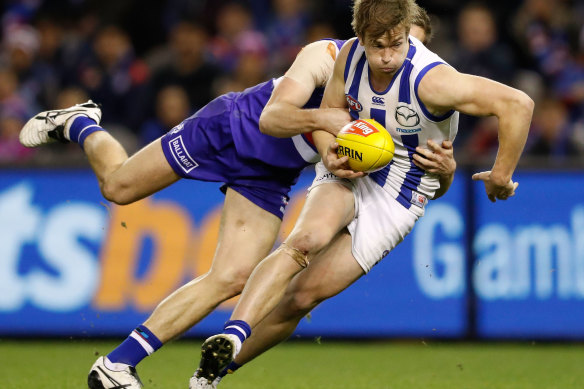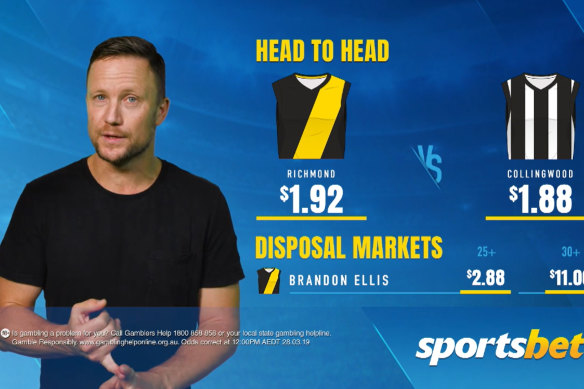Although dwarfed by major categories including food and automotive, gambling is one of the top 20 biggest advertising categories in Australia.
Loading
Data from Nielsen’s Ad Intel Panel claims gambling and gaming companies spent about $310 million on advertising 2022, with the top five spenders including Sportsbet, Tabcorp, Entain (Ladbrokes and Neds) and Pointsbet. The figure has risen year-on-year, with $287.2 spent in 2021, $271.3 million in 2020, and as low as $89.7 million in 2011.
Sources familiar with this data said that more than 50 per cent was spent with commercial television networks, an unsurprising amount given reach of free-to-air audiences. The second most used medium – and a fast-growing one – was digital advertising, which includes YouTube, TikTok and Instagram.
The figures, however, do not account for the millions of dollars spent by wagering companies on sponsorship of stadiums, sports clubs, and sports competitions, not to mention podcasts. When considering these figures, advertising sources believe the total figure spent by the wagering sector blows out to more than $600 million a year.

Advertising figures do not take into account other forms of investment, such as in ground sponsorship.Credit: Getty Images
Broadcasters fear any ban will unfairly target traditional media avenues including television and radio, which are already subject to tight regulations, while “new age media” including YouTube and TikTok will continue to boom largely outside the scope of regulation.
At least four members of Nine’s broadcasting talent have recently been approached by one of Australia’s biggest bookmakers to appear on YouTube and TikTok endorsements, according to sources within the company, indicating a push from wagerers to shore up alternate options if a broadcast ban comes in.
The last two years have seen major long-term broadcast deals signed with sporting bodies including Tennis Australia, Cricket Australia, the NRL and AFL, which has led to industry sources suggesting commercial networks could seek a discount if they lose out on vital ad dollars.
All the sporting rights deals currently in place were agreed upon economics that included gambling advertising, one senior executive told this masthead, though another noted a discount would be unlikely.
Those economics helped the AFL strike a landmark $4.5 billion, seven-year deal with Foxtel and Seven in 2022, the broadcasting combination also securing seven more years of summer cricket coverage with a $1.5 billion deal with Cricket Australia in January this year.
Nine, the publisher of this masthead, also recently agreed a $425 million, five-year extension with Tennis Australia to broadcast the Australian Open through until 2029, as well as a bumper deal with the NRL in December 2021.
The inflation of broadcast rights have mirrored increased advertising investment from wagering firms towards TV networks, aided by the entry of digital firms such as Sportsbet and Bet365.

Former AFL footbller Nathan Brown hosts another Sportsbet ad.
Sponsorship deals add an extra complexity to any potential broadcast advertising ban, which would not regulate against sporting bodies or stadiums accepting money from wagering companies.
Loading
The AFL and NRL both have deals with Sportsbet worth $8 million and $12 million per year respectively, while Cricket Australia receives $3.5 million annually from its deal with Bet365. The majority of NRL teams also have a gambling sponsors present on their jerseys.
Data from Nielsen Sport in 2022 found the NRL sleeve sponsor to be the most valuable advertising piece of advertising real estate in live sports broadcasting, due to its prominent positioning.
Several sporting bodies also receive a cut of turnover from bets placed on matches, referred to as “product fees”, AFL chief executive Gillon McLachlan told the inquiry in April.
The NRL told Four Corners this month it earned as much as $50 million from such deals, with the AFL’s figure estimated between $30 million to $40 million.
While the commercial networks could be set to be the biggest losers of any such ban, last month the Coalition proposed the removal of the broadcast spectrum tax to level the playing field with the digital platforms.
The tax is worth an estimated $10 million annually for each network, and one executive suggested while it would not fill the gap left by gambling advertising revenue, it would “cushion the blow”.
The Business Briefing newsletter delivers major stories, exclusive coverage and expert opinion. Sign up to get it every weekday morning.
Stay connected with us on social media platform for instant update click here to join our Twitter, & Facebook
We are now on Telegram. Click here to join our channel (@TechiUpdate) and stay updated with the latest Technology headlines.
For all the latest Business News Click Here
For the latest news and updates, follow us on Google News.
